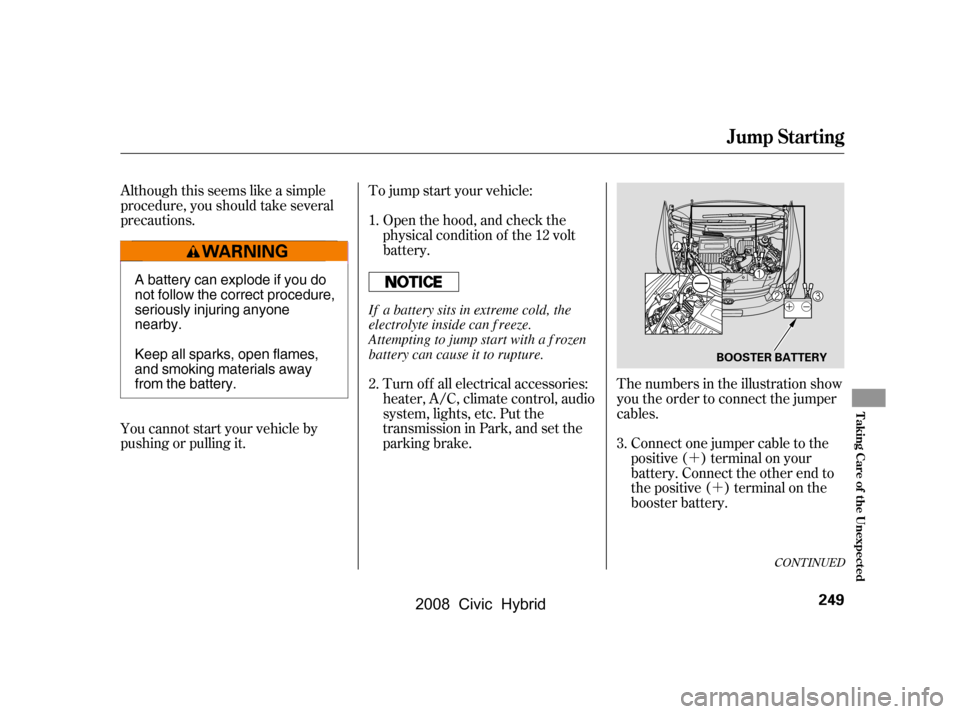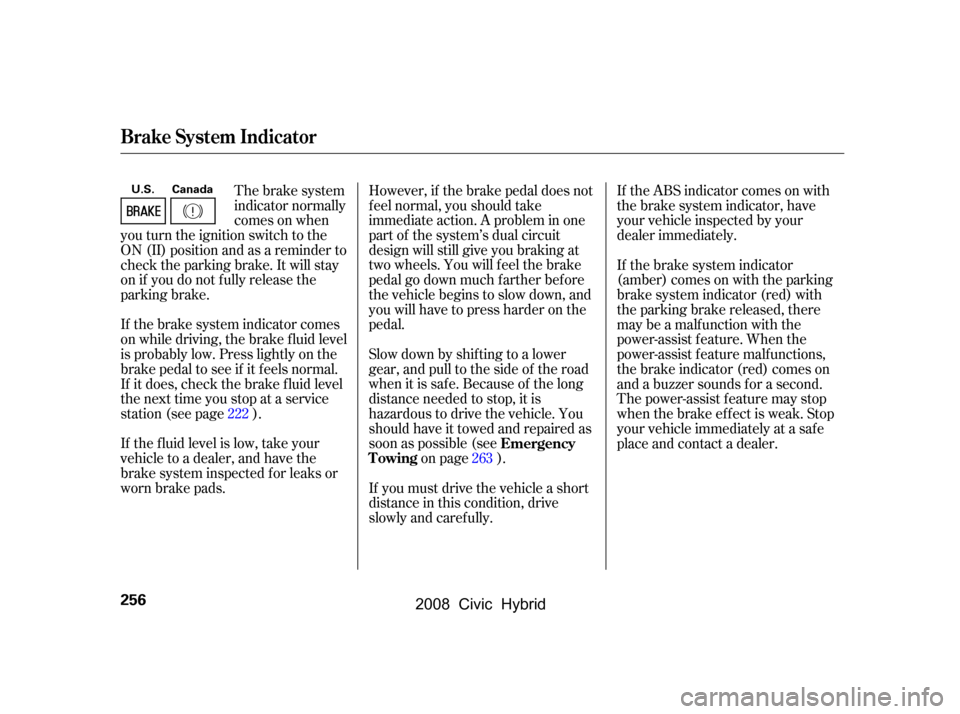Page 252 of 300

�´
�´
Although this seems like a simple
procedure, you should take several
precautions.
To jump start your vehicle:
The numbers in the illustration show
you the order to connect the jumper
cables.
Connect one jumper cable to the
positive ( ) terminal on your
battery. Connect the other end to
the positive ( ) terminal on the
booster battery.
You cannot start your vehicle by
pushing or pulling it.
Open the hood, and check the
physical condition of the 12 volt
battery.
Turn of f all electrical accessories:
heater, A/C, climate control, audio
system, lights, etc. Put the
transmission in Park, and set the
parking brake.
1.
2.
3.
CONT INUED
Jump Starting
T aking Care of t he Unexpect ed
249
BOOSTER BATTERY
A battery can explode if you do
not follow the correct procedure,
seriously injuring anyone
nearby.
Keep all sparks, open flames,
and smoking materials away
from the battery.
If a battery sits in extreme cold, the
electrolyte inside can f reeze.
Attempting to jump start with a f rozen
battery can cause it to rupture.
�����—�����—�����y�
������
��
���y���
�(�#���������y���������y
2008 Civic Hybrid
Page 256 of 300

If necessary, add oil to bring the
level back to the full mark on the
dipstick (see page ).The engine running generates the oil
pressure. When the Auto Idle Stop is
activated, the engine is stopped, the
oil pressure is dropped, and the low
oil pressure indicator does not come
on.
Saf ely pull of f the road, and shut
of f the engine. Turn on the hazard
warning lights.
Let the vehicle sit f or a minute.
Open the hood, and check the oil
level (see page ). An engine
very low on oil can lose pressure
during cornering and other driving
maneuvers.
Start the engine and watch the oil
pressure indicator. If it does not go
out within 10 seconds, turn of f the
engine. There is a mechanical
problem that needs to be repaired
bef ore you can continue driving
(see on page
).
This indicator should never
come on when the engine is
running. If it starts f lashing or stays
on, the oil pressure has dropped very
low or lost pressure. Serious engine
damage is possible, and you should
take immediate action. 1.
2.
3.
4.177
215
263
L ow Oil Pressure Indicator
Emergency T owing
T aking Care of t he Unexpect ed
253
Running the engine with low oil
pressure can cause serious mechanical
damage almost immediately. Turn of f
the engine as soon as you can saf ely get
the vehicle stopped.
�\f���—�\f���—�\f���y�
������
������y���
�(�#�������\f�y�\f�������y
2008 Civic Hybrid
Page 259 of 300

If the ABS indicator comes on with
the brake system indicator, have
your vehicle inspected by your
dealer immediately.
However, if the brake pedal does not
f eel normal, you should take
immediate action. A problem in one
part of the system’s dual circuit
design will still give you braking at
two wheels. You will f eel the brake
pedal go down much f arther bef ore
the vehicle begins to slow down, and
you will have to press harder on the
pedal.
Slow down by shif ting to a lower
gear, and pull to the side of the road
when it is saf e. Because of the long
distance needed to stop, it is
hazardous to drive the vehicle. You
should have it towed and repaired as
soon as possible (see
on page ).
If you must drive the vehicle a short
distance in this condition, drive
slowly and caref ully.
The brake system
indicator normally
comes on when
you turn the ignition switch to the
ON (II) position and as a reminder to
check the parking brake. It will stay
on if you do not f ully release the
parking brake.
If the brake system indicator comes
on while driving, the brake f luid level
is probably low. Press lightly on the
brake pedal to see if it f eels normal.
If it does, check the brake f luid level
thenexttimeyoustopataservice
station (see page ).
If the f luid level is low, take your
vehicle to a dealer, and have the
brake system inspected f or leaks or
worn brake pads. If the brake system indicator
(amber) comes on with the parking
brake system indicator (red) with
the parking brake released, there
may be a malfunction with the
power-assist f eature. When the
power-assist f eature malf unctions,
the brake indicator (red) comes on
and a buzzer sounds f or a second.
The power-assist f eature may stop
when the brake ef f ect is weak. Stop
your vehicle immediately at a saf e
place and contact a dealer.
222
263Emergency
Towing
Brake System Indicator
256
Canada
U.S.
�\f���—�\f���—�\f���y�
���������\f���y���
�(�#�������\f�y�\f�����
�y
2008 Civic Hybrid
Page 261 of 300
Turn the ignition switch to the
LOCK (0) position. Make sure the
headlights and all other
accessories are of f .
Remove the cover f rom the f use
box.
If something electrical in your
vehicle stops working, the first thing
youshouldcheckforisablownfuse.
Determine f rom the chart on pages
and , or the diagram on the
fuse box lid, which fuse or fuses
control that device. Check those
f uses f irst, but check all the f uses
bef ore deciding that a blown f use is
the cause. Replace any blown f uses,
and check if the device works.
Check each of the large f uses in
the primary under-hood f use box
by looking through the top at the
wire inside. Remove the screws
with a Phillips-head screwdriver.
1.
2. 3.
261262
Checking and Replacing Fuses
Fuses
258
BLOWN
FUSE
BLOWN
�\f���—�\f���—�\f���y�
�����������\f�y���
�(�#�������\f�y�\f�������y
2008 Civic Hybrid
Page 264 of 300
�µ
�µNo.
No. Circuits Protected
No. Circuits Protected
Circuits Protected Amps.
Amps.
Amps.
1
2
3
1
2
3 IMA2
IMA1
Booster MS
4
5
6
7
8
9
10
11
12
13
14
15
16
17
18
19
20
21
22
23 Headlight Main
Power Window Main
Booster Motor
Sub Fan Motor
Main Fan Motor
Rear Defogger
Blower
Hazard
FI Sub
Stop and Horn
IG Coil (EX)
IG Coil (IN)
Oil Level
Not Used
Not Used
IG Coil
FI Main
MG Clutch
DBW
Interior Light
Back Up
Main Fuse
EPS
Option Main
Ignition Switch Main
ABS Motor
ABS F/S 50 A
40 A
40 A
20 A
20 A
30 A
40 A
10 A
15 A
15 A
15 A
15 A
7.5 A
20 A
15 A
7.5 A 15 A
7.5 A 10 A 10 A
7.5 A 15 A
100 A
70 A
60 A
50 A
30 A
30 A
Fuse Locations
T aking Care of t he Unexpect ed
261
UNDER-HOOD PRIMARY FUSE BOX UNDER-HOOD SECONDARY FUSE BOX
�\f���—�\f���—�\f���y�
�������������y���
�(�#�������\f�y�\f�������y
2008 Civic Hybrid
Page 265 of 300

�Î
�µ
�µ
�µ�µ
�µ
�µ
�µ
�µ
�Î
No. No. No.
Circuits Protected Circuits Protected
Circuits Protected
Amps. Amps. Amps.
1
2
3
4
5
6
7
8
9
10
11
12
13
14
15
16 17
18
19
20
21
22
23
24
25
26
27
28
29
30
31
32
33
34
35
36
37
38
ODS
MET ER
SRS
Right Headlight High Beam
Left Headlight High Beam
Small (Interior)
Small (Exterior)
Right Headlight Low Beam Left Headlight Low Beam
Headlight High Main
Small (Main)
Not Used
Headlight Low Main
(HAC)
STS
Not Used
Door Lock
Driver’s Power Window
Not Used
Rear ACC Socket
ACC
Passenger’s Power Window
Not Used
Right Rear Power Window
Left Rear Power Window
Not Used
ACC Radio
HAC
Daytime Running Light
Wiper
Power Window
Fuel Pump
IG1 ACG
ABS Unit
Not Used
Not Used
TPMS
Not Used
7.5 A
15 A
10 A
7.5 A
7.5 A 7.5 A
7.5 A
10 A
10 A
10 A
7.5 A
7.5 A 10 A 10 A
20 A
15 A
20 A
(7.5 A)
(7.5 A)
20 A
20 A
(15 A) 15 A
20 A
20 A
20 A
7.5 A 10 A
7.5 A 30 A
: If equipped
Fuse Locations
262
INTERIOR FUSE BOX
�\f���—�\f���—�\f���y�
�������������y���
�(�#�������\f�y�\f�������y
2008 Civic Hybrid
Page 272 of 300

�µ�µ�µ�µ
�µ
�µ
�µ
�µ
�µ
�µ
�µ
�µ
�µ
�µ
�µ
�µ
�µ
�µ
Specif ications
Technical Inf ormation
269
Air Conditioning Fuses
Alignment
12 Volt Battery Tires
Lights
HFC-134a (R-134a)
14.1 15.9 oz (400 450 g) SE-10Y
12 V 60 W
12 V 3 CP
12 V 21/5 W
12 V 21 W 7°6’1°39’ 0°3’
0.00 in (0.0 mm)
P195/65R15 89S 2.0 in (2.0 mm)
Refrigerant type
Charge quantity
Lubricant oil type
Interior
Under-hood
Toe-in
Camber
Caster
12 V
12 V 51 W
12 V 21 W
12 V
12 V
12 V
12 V
5W
8W
8W
5W
Capacity 12 V 35 AH/20 HR T125/70D15 95M
32 psi (220 kPa , 2.2 kgf/cm
)
60 psi (420 kPa , 4.2 kgf/cm)
Size
Pressure
12 V 2 CP
12 V 28 AH/5 HR 24/2.2 CP
Headlights
Front turn signal/side marker
lights
Rear turn signal lights
Brake/Taillights (in fenders)
Back-up lights
Rear side marker lights
Taillights (in trunk lid)
License plate lights
Ceiling light
Spotlights
Trunk light See page257or the fuse label
attached to the inside of the fuse
box door under the steering
column.
See page257or the fuse box
cover.
Front
Rear
Front
Rear
Front
High
Low
(HB3)
(HB4)
Front/Rear
Spare
Front/Rear
Spare
�\f���—�\f���—�\f���y�
�����������\f�y���
�(�#�������\f�y�\f�������y
2008 Civic Hybrid
Page 278 of 300

�Î
�ÎThe burning of gasoline in your
vehicle’s engine produces several by-
products. Some of these are carbon
monoxide (CO), oxides of nitrogen
(NOx), and hydrocarbons (HC).
Gasoline evaporating f rom the tank
also produces hydrocarbons. Con-
trolling the production of NOx, CO,
and HC is important to the environ-
ment. Under certain conditions of
sunlight and climate, NOx and HC
react to f orm photochemical ‘‘smog.’’
Carbon monoxide does not contri-
bute to smog creation, but it is a
poisonous gas. The United States Clean Air Act
sets standards f or automobile
emissions. It also requires that
automobile manufacturers explain to
owners how their emissions controls
workandwhattodotomaintain
them. This section summarizes how
the emissions controls work.
In Canada, Honda vehicles comply
with the Canadian emission
requirements, as specif ied in an
agreement with Environment
Canada, at the time they are
manuf actured.
Your vehicle has a positive
crankcase ventilation system. This
keeps gasses that build up in the
engine’s crankcase f rom going into
the atmosphere. The positive
crankcase ventilation valve routes
them from the crankcase back to the intake manif old. They are then
drawn into the engine and burned.
As gasoline evaporates in the f uel
tank, an evaporative emissions
control canister f illed with charcoal
adsorbs the vapor. It is stored in this
canister while the engine is of f . Af ter
the engine is started and warmed up,
the vapor is drawn into the engine
and burned during driving.
The onboard ref ueling vapor
recovery (ORVR) system captures
the f uel vapors during ref ueling. The
vapors are adsorbed in a canister
f illed with activated carbon. While
driving, the f uel vapors are drawn
into the engine and burned of f .
The Clean Air Act
Crankcase Emissions Control
System
Evaporative Emissions Control
System
Onboard Ref ueling Vapor
Recovery
Emissions Cont rols
Technical Inf ormation
275
�\f���—�\f���—�\f���y�
�������������y���
�(�#�������\f�y�\f�����\f�y
2008 Civic Hybrid